Prison
In many cases, citizens were sentenced to slavery, often in ergastula (a primitive form of prison where unruly slaves were chained to workbenches and performed hard labor).[8] In Medieval Songhai, results of a trial could have led to confiscation of merchandise or imprisonment as a form of punishment, since various prisons existed in the empire.The capability to imprison citizens granted an air of legitimacy to officials at all levels of government and served as a signifier of who possessed power or authority over others.[10] Another common punishment was sentencing people to galley slavery, which involved chaining prisoners together in the bottoms of ships and forcing them to row on naval or merchant vessels.The first was based in Enlightenment ideas of utilitarianism and rationalism, and suggested that prisons should simply be used as a more effective substitute for public corporal punishments such as whipping, hanging, etc.The Transportation Act 1717 made this option available for lesser crimes, or offered it by discretion as a longer-term alternative to the death penalty, which could theoretically be imposed for the growing number of offenses in Britain.Given the undeveloped institutional facilities, old sailing vessels, termed hulks, were the most readily available and expandable choice to be used as places of temporary confinement.Katorga prisons were harsh work camps established in the 17th century in Russia, in remote underpopulated areas of Siberia and the Russian Far East, that had few towns or food sources.Elizabeth Fry documented the conditions that prevailed at Newgate prison, where the ladies' section was overcrowded with women and children, some of whom had not even received a trial.[35] Robert Peel's Gaols Act 1823 introduced regular visits to prisoners by chaplains, provided for the payment of jailers and prohibited the use of irons and manacles.In 1786, the state of Pennsylvania passed a law that mandated that all convicts who had not been sentenced to death would be placed in penal servitude to do public works projects such as building roads, forts, and mines.Besides the economic benefits of providing a free source of hard labor, the proponents of the new penal code also thought that this would deter criminal activity by making a conspicuous public example of consequences of breaking the law.Reformers such as Benjamin Rush came up with a solution that would enable the continued use of forced labor while keeping disorderly conduct and abuse out of the eyes of the public.They suggested that prisoners be sent to secluded "houses of repentance" where they would be subjected (out of the view of the public) to "bodily pain, labor, watchfulness, solitude, and silence ... joined with cleanliness and a simple diet".The aim of this was rehabilitative: the reformers talked about the penitentiary serving as a model for the family and the school and almost all the states adopted the plan (though Pennsylvania went even further in separating prisoners).The system's fame spread and visitors to the U.S. to see the prisons included de Tocqueville who wrote Democracy in America as a result of his visit.After the unification of Italy in 1861, the government reformed the repressive and arbitrary prison system they inherited, and modernized and secularized criminal punishment by emphasizing discipline and deterrence.Smaller, separate and self-contained housing units known as "pods" or "modules" are designed to hold 16 to 50 prisoners and are arranged around exercise yards or support facilities in a decentralized "campus" pattern.[citation needed] Pods may be designed for high-security "indirect supervision", in which officers in segregated and sealed control booths monitor smaller numbers of prisoners confined to their cells.[66][67] Modern prisons often hold hundreds or thousands of inmates, and must have facilities onsite to meet most of their needs, including dietary, health, fitness, education, religious practices, entertainment, and many others.[75] Analysis of data in 2000 from several forensic hospitals in California, New York and Oregon found that with treatment the rate of recidivism was "much lower" than for untreated mentally ill offenders.This time spent reading has a variety of benefits including improved literacy, ability to understand rules and regulations (leading to improved behavior), ability to read books that encourage self-reflection and analysis of one's emotional state, consciousness of important real-world events, and education that can lead to successful re-entry into society after release.They warn against the dehumanizing nature of rehabilitative practices and encourage the maintenance of agency and control in these programs to prevent them from becoming self-serving entities that cause further exploitation.[85] Taking an alternative approach, queer literacy frameworks have also been supported by scholars like Alexandra Cavallaro who see the incorporation of LGBTQ individuals' stories as key to promoting lifelong learning.Examples of common facilities/programs that are available in some prisons are: gyms and weightlifting rooms, arts and crafts, games (such as cards, chess, or bingo), television sets, and sports teams.[94] Besides prisons, many other types of residential placement exist within juvenile justice systems, including youth homes, community-based programs, training schools and boot camps.[93] Like adult facilities, youth detention centers in some countries are experiencing overcrowding due to large increases in incarceration rates of young offenders.Many critics note high juvenile recidivism rates, and the fact that most of the youths that are incarcerated are those from lower socio-economic classes (who often suffer from broken families, lack of educational/job opportunities, and violence in their communities).[135][136] Some scholars, using the term prison-industrial complex, have argued that the trend of "hiring out prisoners" is a continuation of the slavery tradition, pointing out that the Thirteenth Amendment to the United States Constitution freed slaves but allowed forced labor for people convicted of crimes.[181] The movement is associated with libertarian socialism, anarchism and anti-authoritarianism, with some prison abolitionists arguing that imprisoning people for actions the state designates as crimes is not only inexpedient but also immoral.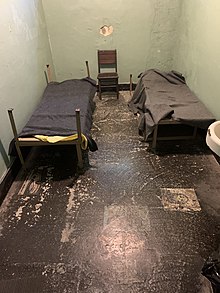



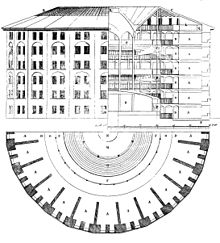


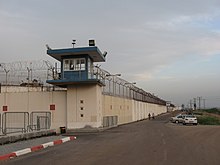








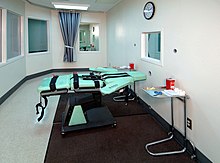



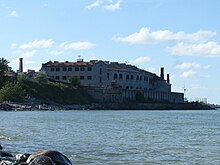


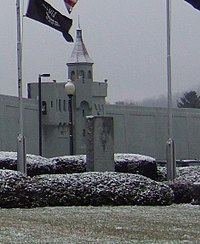
Prison (disambiguation)Jail (disambiguation)Penitentiary (disambiguation)CriminologypenologyAnomieBiosocial criminologyBroken windowsCollective efficacyCrime analysisCriminalizationDifferential associationDevianceExpressive function of lawLabeling theoryPsychopathyRational choiceRisk & actuarial criminologySocial controlSocial learningStrainSubcultureSymbolic interactionismVictimologyÉmile DurkheimHans EysenckEnrico FerriMichel FoucaultAlexandre LacassagneCesare LombrosoArchibald ReissHumanityPersonBlue-collarWhite-collarCold casePerfectCorporateInternationalJuvenileOrganizedPoliticalPublic-orderState-corporateTransnationalVictimlessComparativeProfilingCritical theoryEthnographyUniform Crime ReportsCrime mappingCrime statisticsPositivist schoolQualitativeQuantitativeDenunciationDeterrenceIncapacitationabolitionreformPrisonerPrisoner abusePrisoners' rightsRehabilitationRecidivismJusticeParticipatoryRestorativeTransformativeRetributiveSolitary confinementAnarchistChicagoClassicalConflictCriticalEnvironmentalFeministIntegrativeItalianMarxistNeo-classicalPositivistPostmodernistAmericanAnthropologicalCulture CyberDemographyDevelopmentExperimentalOrganizationalPublicRadical criminologyPeoplePennsylvaniaimprisonedpunishmentcrimescriminal-justiceimprisoned until their trialguilty sentencedpolitical repressionauthoritariandetain perceived opponentspolitical crimesdue processinternational lawadministration of justiceprisoners of wardetaineesmilitary prisonsprisoner-of-war campsinternment campsAmerican Englishpre-trial detentionsheriffsentencedNew ZealandPapua New GuineaAustraliaMaitland GaolNew South WalesQueensland